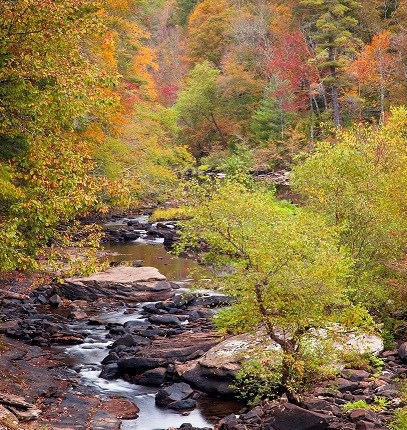Learn about NRCAs
The Natural Resource Condition Assessment (NRCA) Program provides framework, funding, and publishing support to parks to aid in the synthesis and documentation of natural resource conditions. Condition assessment reports are a tool to describe selected park resources, and record a snapshot of their current condition, identify trends, and identify potential or current threats and stressors. Understanding the condition and trend of natural resources is key for parks and NPS planners to appropriately prioritize and allocate stewardship resources.

NPS Photo.
The park protects approximately 64.4 river km (40 river mi) of the Obed and Emory Rivers, as well as Clear Creek and Daddy’s Creek.
Traditional NRCA Report: 2017
In an effort to better understand the natural resources and processes present in this park, a Natural Resource Condition Assessment was conducted and published in 2017. This assessment was a collaborative effort between the National Park Service and St. Mary’s University of Minnesota. This team selected eleven resources within the park to be evaluated:
- Landscape dynamics |
- Cobble bars / river scour prairies |
|||||
- Native forests / other plant communities |
- Freshwater invertibrates |
|||||
- Mammals |
- Water quality |
|||||
- Birds |
- Water quantity |
|||||
- Fish communities |
- Dark night skies |
|||||
|
|
- Acoustic environment |
Obed Wild and Scenic River was established primarily to protect a diverse river system, which provides habitat for a variety of rare and unique species (e.g., mussels, fish, endemic plants). The park also includes spectacular geological features and valuable native forests, offering habitat for terrestrial wildlife. This assessment serves as a review and summary of available data and literature for featured natural resources within the park. Only one of the components assessed by this review was considered to be in good condition: fish communities. Five components were of moderate concern (native forests/other plant communities, birds, cobble bars/river scour prairies, water quality, water quantity, and dark night skies), and two components (landscape dynamics and freshwater invertebrates) were considered to be of significant concern. In addition, condition of two resources (mammals and acoustic environment) could not be determined.
Through the understanding of the condition of these resources and data needs, park resource managers can prioritize management and research objectives to better focus conservation strategies in order to maintain the health and integrity of park ecosystems.
Through the understanding of the condition of these resources and data needs, park resource managers can prioritize management and research objectives to better focus conservation strategies in order to maintain the health and integrity of park ecosystems.
For other reports and natural resource datasets visit the NPS Data Store.
Source: NPS DataStore Collection 7765 (results presented are a subset). To search for additional information, visit the NPS DataStore.
Last updated: February 25, 2022
